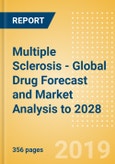Summary
Multiple Sclerosis (MS) therapeutics market has entered an exciting phase, with an upsurge of available treatment options and several promising late-stage pipeline products offering diverse mechanisms of action (MOA). The latest research report “Multiple Sclerosis: Global Drug Forecast and Market Analysis to 2028” expects the Multiple Sclerosis (MS) market to grow in sales from $19.8bn in 2018 to $32.9bn in 2028 with a compound annual growth rate (CAGR) of 5.2%, due to the launch of 11 new pipeline agents providing more options for patients and stimulating further competition.
Multiple Sclerosis (MS) is a primary autoimmune disease with a mechanism involving recurrent inflammatory attacks on the central nervous system (CNS) due to a dysfunctional immune system, leading to neurological disability. Multiple Sclerosis (MS) is primarily considered an inflammatory demyelinating disorder of the CNS, and is characterized by lymphocyte and macrophage infiltrates, as well as glial cell activation. Multiple Sclerosis (MS) patients are generally grouped into four major categories on the basis of the disease course. These categories are Relapse-Remitting Multiple Sclerosis (RRMS), Secondary Progressive Multiple Sclerosis (SPMS), Primary Progressive Multiple Sclerosis (PPMS), and Progressive Relapsing Multiple Sclerosis (PRMS).
The Multiple Sclerosis (MS) pipeline is strong and diverse with a total of 49 products in all stages and phases of clinical development, of which 24 are early-stage and 25 are in the late-stage pipeline. Progressive Multiple Sclerosis (MS) is a significant focus for product development, with seven of the late-stage products targeting this patient group as an initial indication. There is currently a distinct lack of Disease Modifying Therapies (DMT) options for patients with progressive Multiple Sclerosis (MS) subtypes, and these populations remain significantly underserved.
The 11 new pipeline agents have a broad range of MOA, including anti-CD20 antibodies, three second generation S1P receptor modulators, an anti-LINGO-1 antibody, a tyrosine kinase inhibitor, a Repulsive Guidance Molecule A (RGMA) Inhibitor and antioxidants. Further, 14 late-stage drug products will launch in the seven major markets (7MM - US, France, Germany, Italy, Spain, UK and Japan) during, or shortly after, the forecast period from 2018 to 2028.
While physicians might be persuaded that there may be some advantages of the newer generation, the pipeline developers may find it difficult to persuade payers, or insurance companies to use their drug over fingolimod generics, especially in the US, where branded drug prices are high.
The current Multiple Sclerosis (MS) market is highly competitive, with 14 available treatment options, most of which are immunomodulatory agents. The majority of approved treatments address the inflammatory and systemic origins of the disease, but few possess neuroprotective effects and, as such, have an insufficient impact on the underlying neurologic deterioration caused by Multiple Sclerosis (MS). Remyelination strategies could prove revolutionary for Multiple Sclerosis (MS), as they address a key pathophysiological aspect of the disease that is thought to contribute to the accrual of permanent disability.
The Multiple Sclerosis (MS) market is heading towards earlier and more aggressive therapies, with studies in the US questioning whether people with Multiple Sclerosis (MS) who are recently diagnosed should already go on with one of the monoclonal antibody therapies.
Scope
- Overview of Multiple Sclerosis, including epidemiology, etiology, pathophysiology, symptoms, diagnosis, and disease management.
- Annualized Multiple Sclerosis therapeutics market revenue, cost of therapy per patient, and treatment usage patterns in three patient segments (RRMS, SPMS and PPMS) forecast from 2018 to 2028.
- Key topics covered include strategic competitor assessment, market characterization, unmet needs, clinical trial mapping and implications for the Multiple Sclerosis therapeutics market
- Pipeline analysis: comprehensive data assessing emerging trends and mechanisms of action under development for Multiple Sclerosis therapy. The most promising candidates in Phase III development are profiled.
- Analysis of the current and future market competition in the global Multiple Sclerosis therapeutics market. Insightful review of the key industry drivers, restraints and challenges. Each trend is independently researched to provide qualitative analysis of its implications.
Reasons to buy
The report will enable you to -
- Develop and design your in-licensing and out-licensing strategies through a review of pipeline products and technologies, and by identifying the companies with the most robust pipeline.
- Develop business strategies by understanding the trends shaping and driving the global Multiple Sclerosis therapeutics market.
- Drive revenues by understanding the key trends, innovative products and technologies, market segments, and companies likely to impact the global Multiple Sclerosis therapeutics market in the future.
- Formulate effective sales and marketing strategies by understanding the competitive landscape and by analysing the performance of various competitors.
- Identify emerging players with potentially strong product portfolios and create effective counter-strategies to gain a competitive advantage.
- Organize your sales and marketing efforts by identifying the market categories and segments that present maximum opportunities for consolidations, investments and strategic partnerships.
Table of Contents
Companies Mentioned (Partial List)
A selection of companies mentioned in this report includes, but is not limited to:
- Teva
- Roche
- TG Therapeutics
- Avadel Pharmaceuticals
- GSK
- GeNeuro
- Biogen
- AbbVie
- Celgene
- Actelion
- Jannsen
- AB Science
- MedDay
- MediciNova
- Merck Serono
- Sanofi
- Bayer
- Novartis








